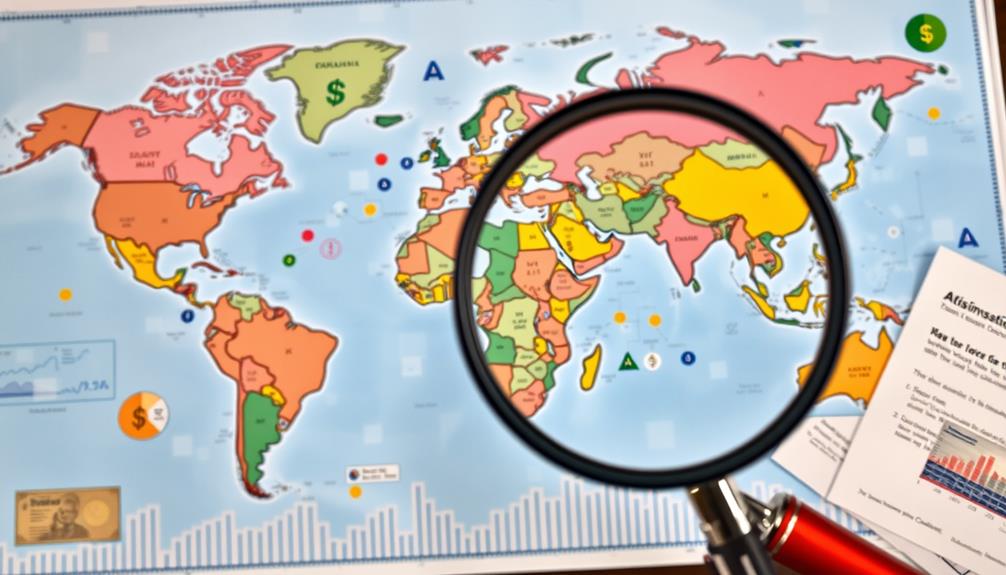To expand the diversity of your IRA with international investments, begin by allocating a minimum of 20% of your portfolio to global stocks and bonds. Explore emerging markets for increased growth potential, aiming to allocate approximately 15% to 20% of your international holdings there. Utilize mutual funds or ETFs to gain easier access to these markets. Be mindful of tax implications, such as potential withholding on foreign dividends. Managing currency risk is also crucial, so stay vigilant about fluctuations in exchange rates. Implementing these strategies can significantly enhance the growth of your portfolio. Uncover more insights to refine your investment approach.
Key Takeaways
- Allocate at least 20% of your IRA portfolio to international stocks and bonds for effective diversification.
- Explore foreign dividend stocks to enhance global exposure, keeping in mind withholding tax implications.
- Utilize mutual funds and ETFs to simplify access to international markets and investment processes.
- Monitor currency trends and consider hedging strategies to manage currency risk in foreign investments.
- Stay informed on geopolitical events and economic indicators to make timely investment adjustments.
Benefits of International Investments

Investing internationally often provides significant diversification benefits for your portfolio. By incorporating international investments, you can potentially reduce overall portfolio volatility, as non-U.S. markets don't always move in tandem with domestic markets. This can help shield your investments during turbulent times.
Additionally, diversification strategy is essential, as it reduces risk by spreading investments across various assets.
When you explore foreign markets, you gain access to growth opportunities in emerging economies, often presenting higher returns than developed markets. These regions can be hotbeds for innovation and expansion, enhancing your investment strategy.
Additionally, international stocks expose you to different economic cycles and industries, broadening your portfolio's reach.
Currency diversification is another key advantage. Fluctuations in foreign currencies can lead to gains when converted back to U.S. dollars, providing an added layer of potential profit.
While U.S. markets have historically outperformed foreign markets over the last decade, experts predict international markets may shine in the coming years due to valuation advantages.
Understanding Foreign Dividend Stocks

Foreign dividend stocks can be a valuable addition to your Roth IRA, offering both diversification and exposure to global markets. By investing in these assets, you can tap into international economic growth, which can enhance your portfolio's performance.
Additionally, similar to Gold IRAs, foreign dividend stocks can provide a hedge against domestic market volatility. However, there are important factors to take into account:
- Withholding Taxes: Countries may impose taxes on dividends, varying widely (e.g., 26% in Italy, 19% in Spain).
- Foreign Tax Credits: Unlike taxable accounts, you can't claim foreign tax credits in a Roth IRA, complicating tax implications.
- Currency Fluctuations: Changes in currency values can affect the actual returns you receive from foreign dividends.
- Accessibility: Advances in technology have improved access to international markets, making it easier to invest in foreign dividend stocks.
- Diversification: Incorporating these stocks can help mitigate risks associated with domestic investments.
While foreign dividend stocks can enhance your Roth IRA, understanding these factors is essential. Weigh the potential risks and rewards to make informed investment choices that align with your long-term financial goals.
Tax Implications for International Assets

When pondering international assets for your IRA, it's vital to understand the tax implications that come into play. Foreign dividends from international investments may be subject to withholding taxes imposed by foreign governments, which can greatly reduce your net income. For example, Italy imposes a 26% withholding tax while Spain has a 19% rate, affecting the overall returns on your investments.
Additionally, it's important to reflect on how diversifying with precious metals, such as gold, can serve as a hedge against currency fluctuations and inflation during international investments, especially when exploring IRA rollover to gold.
Unlike taxable accounts, dividends from foreign stocks held in your IRA won't show up on your U.S. tax returns, delaying your tax liability until you make withdrawals. While you might think about foreign tax credits to offset these costs, you can't claim them within an IRA.
However, you may benefit from tax treaties that could lower the withholding tax rates for specific countries, but be aware of the individual tax implications.
Canadian stocks are a notable exception since they don't impose withholding taxes on dividends distributed within IRAs, making them an attractive option for U.S. investors looking to diversify internationally. Understanding these nuances will help you make informed decisions about international assets in your retirement portfolio.
Managing Currency Risk

When investing internationally, you need to be aware of currency risk, as fluctuations in exchange rates can affect your returns.
The importance of sector performance metrics for investors becomes even more pronounced in the context of international investments. If the value of a foreign currency drops, it can diminish the worth of your investments, even if the assets themselves perform well.
Using hedging strategies, like currency futures or options, can help protect your portfolio from these unpredictable movements.
Currency Hedging Strategies
Maneuvering the complexities of international investments often means confronting currency risk, which can greatly affect your returns.
To effectively manage this risk, you'll want to evaluate various currency hedging strategies. For instance, utilizing precious metal investments, such as those offered by Noble Gold, can serve as a hedge against currency fluctuations while also providing a stable value over time.
These strategies can help you mitigate the impact of exchange rate fluctuations on your investment portfolio.
Here are some effective ways to hedge against currency risk:
- Currency forward contracts: Lock in exchange rates for future transactions.
- Currency exchange-traded funds (ETFs): Gain exposure to specific currencies or currency baskets.
- Currency options: Secure the right to exchange currencies at predetermined rates, offering flexibility.
- Regular monitoring: Keep an eye on currency trends to adapt your strategies as needed.
- Diversification: Use a mix of hedging techniques to enhance overall stability.
Impact of Exchange Rates
Understanding the impact of exchange rates is essential for managing currency risk in your international investments. Currency risk arises from fluctuations in exchange rates, which can greatly influence the value of your foreign stocks and overall returns.
For instance, if you're holding stocks in a Roth IRA, you might face withholding taxes on dividends that are heavily affected by the strength of the local currency against the USD.
Additionally, the historical performance trends of gold can serve as a benchmark for evaluating the relative stability of foreign investments compared to precious metals. Long-term currency trends, like the depreciation of the British Pound (GBP) against the US Dollar (USD), can erode gains from your investments, making it vital to monitor these changes closely.
To mitigate potential losses from currency volatility, consider employing hedging strategies, such as currency exchange contracts. While these strategies can help protect your investment portfolio, they might also introduce additional costs and complexities.
Accounting Challenges With Foreign Investments

When you invest internationally, you'll quickly notice that global accounting standards can vary widely from country to country. This variability creates challenges in accurately reporting and evaluating your foreign assets, especially when it comes to understanding how these investments fit within a diversified retirement portfolio.
Additionally, the complexities of gold IRA rollovers can further complicate matters, so it's crucial to reflect on the importance of research before diving into international investments.
Plus, the complex reporting requirements for foreign dividends can lead to confusion and mistakes if you're not careful.
Global Accounting Standards Variability
Maneuvering through the complexities of global accounting standards can be intimidating, especially since these standards often vary considerably across countries.
When you invest in foreign investments, you face unique challenges due to these differences in international accounting practices. Understanding these variances is essential for accurate financial reporting and compliance.
Additionally, employing a holistic SEO approach can enhance your understanding of market dynamics, ultimately aiding in better investment decisions.
Here are some key considerations:
- Global accounting standards can differ, complicating investment analysis.
- Reporting requirements for foreign dividends often lead to confusion about income recognition.
- Unique local regulations can impact investment transparency and compliance.
- Familiarity with diverse tax obligations is necessary to avoid penalties.
- Consulting with tax experts can help clarify specific regulations.
Reporting Requirements Complexity
Steering through the reporting requirements for foreign investments can feel like a challenging puzzle for investors. The complexity arises from varying global accounting standards and diverse tax implications across countries.
When you invest in international assets, understanding withholding taxes becomes essential, as these rates can considerably differ. Additionally, keeping an eye on free crypto opportunities can enhance your overall investment strategy.
Unfortunately, foreign dividends received in your IRA don't appear on U.S. tax returns, making it tough to claim the foreign tax credit or deductions for those withholding taxes.
Moreover, the lack of IRS reporting for IRA activities means you might miss valuable opportunities for tax optimization. Without the ability to report foreign tax withheld on dividends, you could be leaving money on the table.
This intricate landscape of international investments demands more than just basic knowledge; you'll need to navigate complex reporting requirements and guarantee compliance with various regulations.
To effectively manage these challenges, consulting tax experts is highly advisable. They can help clarify specific regulations and guide you through the maze of accounting standards.
Research and Expert Consultation

Thorough research and expert consultation are essential components of successful international investing. Before diving into foreign markets, you need to understand the economic conditions and potential risks tied to international stocks.
This is especially important as the global landscape is constantly evolving, with new opportunities arising in sectors such as AI software engineering jobs that can impact market trends. Consulting with financial experts can help you navigate the complexities of global investing, particularly regarding tax implications and investment strategies.
Here are some key areas to focus on:
- Research foreign markets to identify growth opportunities.
- Stay updated on geopolitical events that may affect your investments.
- Utilize reputable resources like the SEC Office of International Affairs.
- Engage in continuous education on international investing strategies.
- Consult financial experts to tailor your approach for a diversified portfolio.
Recent Market Performance Trends

International investments have shown varied performance trends in recent years, making it essential for investors to stay informed. From 2014 to 2023, non-US stocks have lagged behind the US Market Index in eight out of ten years, reflecting challenges in market performance.
However, in 2022, these international stocks surprisingly outperformed their US counterparts during a bear market, highlighting their potential resilience.
In 2023, the Morningstar Global Markets ex-US Index gained 16%, while the US index achieved a 26% gain, showcasing a continued divergence in performance. The Emerging Markets Index experienced a 12% gain, underperforming the Developed Markets ex-US Index, which rose by 18%.
This indicates significant differences in regional market performance, vital for US investors considering diversification in their portfolios.
Interestingly, over the past three years, the correlation of international stock benchmarks with the US market has increased, particularly among developed markets.
European stocks have shown the highest correlation to US equities, which could influence your decisions when investing in foreign securities or a stock index fund.
Understanding these trends can help you navigate the complexities of international investments.
Strategies for Portfolio Diversification

When it comes to diversifying your IRA, incorporating international investments can be a game-changer for your portfolio. By allocating funds to foreign countries, you can reduce volatility and enhance overall performance.
Here are some strategies to contemplate for effective portfolio diversification:
- Allocate at least 20% of your portfolio to international stocks and bonds.
- Increase exposure to emerging markets by dedicating 15% to 20% of your international investments for significant growth potential.
- Utilize mutual funds and ETFs to easily access global markets, simplifying your investment process.
- Monitor global economic indicators regularly to make informed decisions about your international investments.
- Adjust your allocation based on geopolitical events and market conditions to stay aligned with your investment goals.
Frequently Asked Questions
How Do I Diversify My IRA Investments?
To diversify your IRA investments, consider allocating at least 20% to various asset classes, like stocks and bonds. Use mutual funds or ETFs to simplify the process and minimize risks while enhancing growth potential.
Can You Invest in International Stocks in an Ira?
Imagine casting your net wide in a vast ocean of investment options. Yes, you can invest in international stocks within your IRA. It's a smart way to diversify and tap into global market potential.
What Percentage of My IRA Should Be International?
You should consider allocating at least 20% of your IRA to international assets. If you're comfortable with more risk, aim for 30-40% in international stocks and 30% in international bonds for better diversification.
Is International Diversification Worth It?
International diversification's definitely worth it. It reduces volatility, opens up access to unique growth opportunities, and can enhance your portfolio's performance. By investing abroad, you're positioning yourself for potential higher returns and broader market exposure.
Conclusion
Incorporating international investments into your IRA can enhance your portfolio and open doors to new opportunities. Remember, "don't put all your eggs in one basket." By diversifying globally, you not only mitigate risk but also tap into potential growth in foreign markets. As you navigate this journey, stay informed about tax implications, currency risks, and market trends. Consulting experts can guide you, ensuring your investments align with your financial goals while maximizing your returns.
Helen brings a wealth of experience in investment strategy and a deep passion for helping individuals achieve their retirement goals. With a keen understanding of market dynamics, Helen has been instrumental in shaping the vision and direction of Gold IRA Markets. She specializes in creating innovative solutions that align with our clients’ long-term investment objectives.










